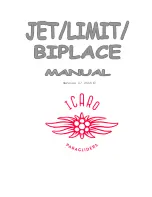
— 13 —
but to follow the procedure before tensioning the crossbar. The other is to install the wands and
wand cups before installing any battens or tensioning the crossbar. To do this, install the wand into
the wand receptacle as described above. Then, sitting on the ground with the wing tip in front of
you, grasp the wand in one hand and the cam lever pull string in the other hand. Pull straight back
on the cam lever pull string until the cup is beyond the end of the wand, and install the cup onto the
wand. Either of these methods is an acceptable alternative to the primary method described
above, and you may find either or both to be easier. The disadvantage of either of these two
methods is that because the crossbar is not tensioned, the top side wires are not holding the tips
off the ground, so the tip area of the sail is more exposed to dirt and wear.
10. The next step is to cam over the tip wand cam lever, tensioning the sail at the tip. Grasp the pull
string attached to the cam lever in one hand, and with the other hand firmly grasp the bottom
surface of the sail at the tip at the velcro opening. Pull your hands towards each other to rotate the
cam lever first towards the keel and then against the tip wand.
11. After you cam the lever over, check to see that the "back" label is properly aligned - it should now
lie directly under that cam lever. Look into the sail from the tip and verify that the most outboard
internal rib is fully zipped up.
12. Install the remaining outboard top surface battens. Secure the shortest cambered battens with a
double purchase loop of the 205 leech line. After installing the tip battens, open the velcro closure
between the top and bottom surface at the tip, and while supporting the tip batten with light
upward pressure, re-close the opening and secure the velcro attachment. (This is to ensure that
both surfaces of the sail mate cleanly in this area).
13. At this time you can install the batten tips for the cambered battens into the hem of the trailing
edge. The lever tip incorporates a hinge and a snap locking mechanism, as well as a threaded
shank that allows for adjustment of the overall batten length, and hence the chordwise tension that
the batten puts on the sail. The locking mechanism can be broken if it is not released properly
before the lever portion of the tip is rotated upwards. If it does break, it will usually break at the
locking hook on the lever (rear) portion of the tip. Also the hinge portion can pop apart relatively
easily. (This is not a failure of the tip, and you can easily pop the hinge back together again.)
Summary of Contents for Sport 2 155
Page 1: ...Sport 2 155 Owner Service Manual June 1st 2004 First Edition...
Page 2: ......
Page 6: ......
















































